Website Media Post
| 21 minutesWebsite Media Posts refers to a piece of content, typically consisting of text, images, videos, or a combination thereof, that is created and posted as Featured Content & Articles, as well as Landing Pages on the AdvaCare Website:https://www.advacarepharma.com/en/news
Objectives
- Establishing authority and credibility of the company in the industry.
- Promoting a brand, product, service, idea, or message to a specific/general target audience
- Enhancing SEO Performance and driving traffic to the website
- Engage, inform, entertain, or inspire the audience, ultimately driving desired actions of Lead generation
- As a landing page for a SEO keyword-driven or scheduled main campaigns
Purpose: This SOP provides detailed guidelines for creating industry-related, informative, brand-building, and SEO-focused content for publication on the company website.
Permanent vs. Scheduled Campaign
Website Media Posts are a part of AdvaCare Permanent Campaign, meaning that it runs on a schedule continuously regardless of what Main/Side Campaign is currently ongoing. However, it can also be used as a Marketing Channel for a scheduled Main/Side Campaign to complement the marketing plan for said campaign.
When scheduling the Yearly/Quarterly Scheduled Campaign, Campaign Specialist can fill in the dates and topics related to MC/SC in the Website Media schedule first, to fill up spots related to the Campaign. Additionally, Website Media Posts will also be a type of content to be shared via Email Marketing Newsletter and Social Media Posts from Permanent/Scheduled Campaigns, therefore the launch of this campaign channel must be coordinated ahead of time with the other two channels.
Type of Posts & Tags
Website Media Posts can be categorized into 4 types of posts:
- Featured Content for Distributors
- Blog Posts
- SEO-focused Landing Pages
- Campaign Landing Pagess
Following are the three types of posts with their key differences. Note that on the Media page, there are dozens of Post Tags that help readers to navigate to various topics of available articles. There are certain rules that apply to the Tags depending on the type of posts, which are also explained on the below tables.
The full list of the of List of Tags can be found here:
Media Articles Tags & Dates Translation (EN_ES_FR)
1. Featured Contents for Distributors |
||
|---|---|---|
| Purpose | Provide in-depth information and resources for distributors/potential distributors to drive engagement. |
Example:

Veterinary Featured Content Tags: 1 Main Tag from the following:
5 Other Tags from the full list: Media Articles Tags & Dates |
| Target Audience | B2B (Distributors & Potential Distributors) | |
| Content Focus | Business-oriented information, promotional material, and CTAs to encourage distributor action. | |
| SEO Role | Minimal SEO; primary focus is engagement and conversion of distributors. | |
| Visibility | Public | |
| Key Features | Detailed B2B information, multiple CTAs, brochures, and downloadable resources. | |
| CTAs | High number of CTAs, leading to product inquiries, distributor sign-ups, or resource downloads. | |
| Tone of Voice | Professional, authoritative, and solution-focused. Encourages trust and expertise in industry partnerships. | |
2. Blog Posts |
||
|---|---|---|
| Purpose | Drive traffic to the website, build backlinks, and improve brand visibility and search rankings. |
Example:
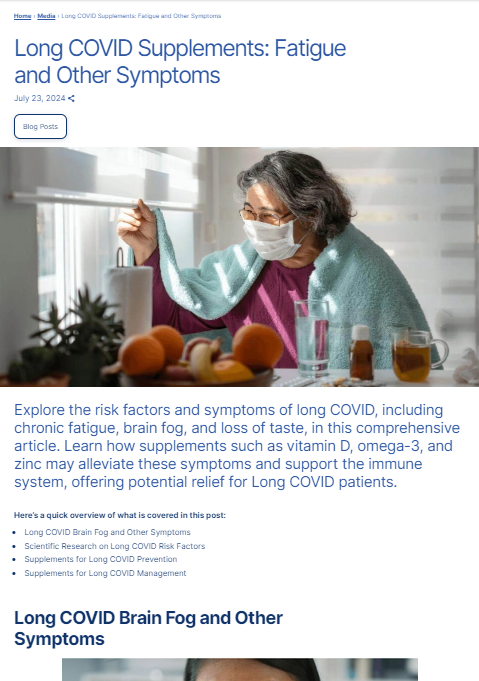
Long COVID Supplements Tags: 1 Main Tag
|
| Target Audience | B2C (General Audience, Customers, Public) | |
| Content Focus | Informative, engaging, and educational content, consumer-oriented topics. | |
| SEO Role | High priority for SEO; focused on driving organic traffic, boosting brand awareness, and gaining backlinks. | |
| Visibility | Public | |
| Key Features | Consumer-focused content, SEO-optimized with relevant keywords, images, and links. | |
| CTAs | Light CTAs, encouraging further reading, product exploration, or social media sharing. | |
| Tone of Voice | Engaging, informative but easily understandable. Engages readers and offers answers to general questions they may have. | |
3. SEO-focused Landing Pages |
|||
|---|---|---|---|
| Purpose | Optimize for specific SEO keywords (Hidden) |
Example:

Pharmaceutical Manufacturers in Turkey Tags: NONE |
|
| Target Audience | B2B audiences on Search Engine platforms | ||
| Content Focus | Short, keyword-focused content for SEO | ||
| SEO Role | High priority for SEO; focused on driving organic traffic. | ||
| Visibility | Hidden from main site navigation | ||
| Key Features | Quick SEO optimization through keyword-rich content | ||
| CTAs | None to minimum amount CTAs | ||
| Tone of Voice | Direct, persuasive, and action-oriented. Creates incentive for distributors to explore other pages of the website. | ||
4. Campaign Landing Pages |
||
|---|---|---|
| Purpose | Support specific campaigns targeting distributors |
Example:
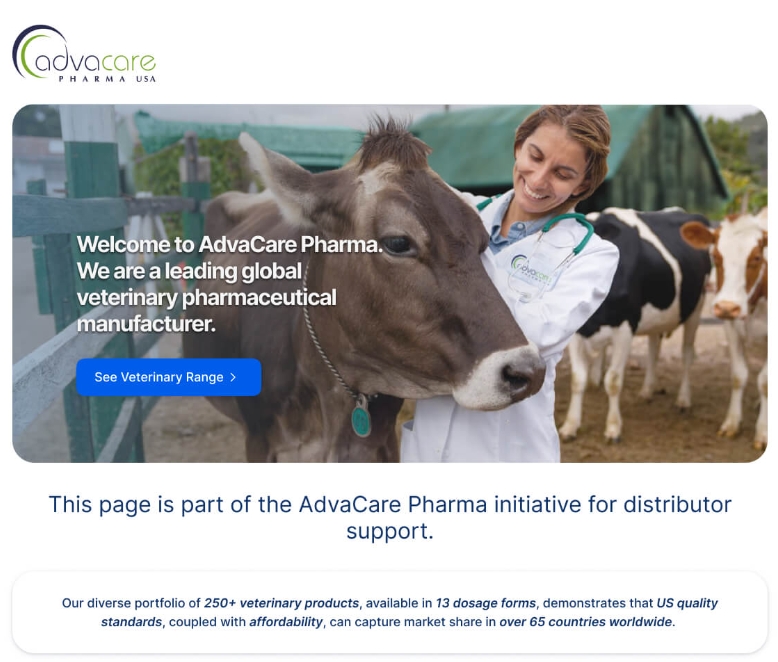
AdvaCare Pharma Veterinary Range Tags: 1 Main Tag from the following:
|
| Target Audience | B2B Audience List from a Campaign | |
| Content Focus | Campaign-specific information for distributors | |
| SEO Role | Minimal SEO focus, mainly for targeted campaign visibility. | |
| Visibility | Visible as part of campaigns, shared through links rather than easily found | |
| Key Features | Campaign-focused messaging with clear distributor CTAs | |
| CTAs | High CTAs for distributor engagement in campaigns (e.g., product trials, sign-ups)g. | |
| Tone of Voice | Direct, persuasive, and action-oriented. Creates urgency for distributors to take specific steps. | |
On the main Media Page, sections shown are as follows:
- Primary Articles: where Featured Contents are shown and can be filtered by its Main Tags and Sub-Tags. Newly created Featured Contents must be manually added to this Featured Content section.
- Secondary Articles:all other articles, shown from the latest to oldest based on the date of publishing. Note that Landing Pages that are supposed to be hidden should NOT be showing in this section, even if recently published.
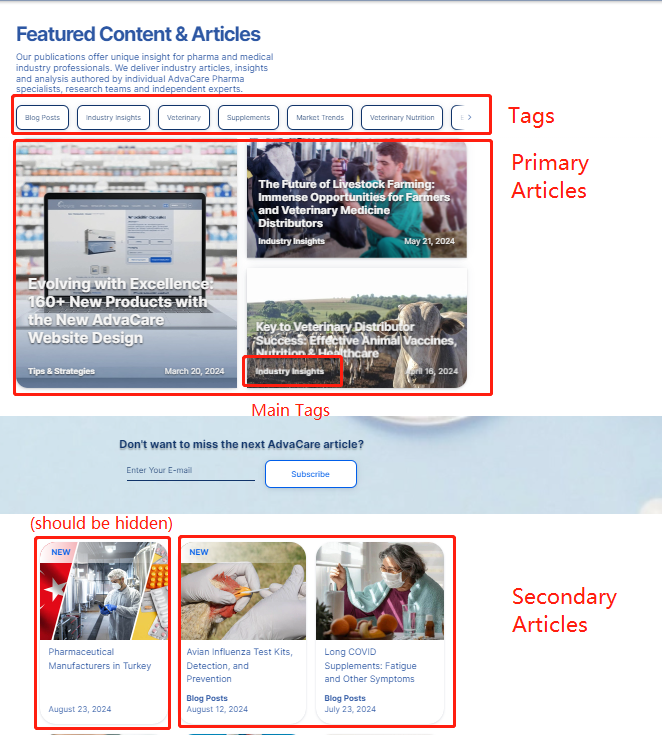
Platform, Frequency & Schedule
At the moment, Website Media Posts are intended only for the company Website and not other external sites. To coordinate the schedule of the Website Media Posts with other marketing channels, find the following suggested schedule.
| Pages | Frequency | Schedule | |
|---|---|---|---|
| AdvaCare Website | Featured Content Post | Minimum of 1x/month | Mondays, according to Campaign Schedule |
| SEO-Focused Landing Page Post | According to Campaigns | Tuesdays-Thursdays | |
| Campaign Landing Pages | According to Campaigns | Anyday, according to Campaign Schedule | |
| Blog Posts | 1x/week | Tuesdays-Thursdays, according to Campaign Schedule | |
| Newsletter | Featured Content Newsletter | With every Featured Content WMP | Tues/Weds of the same week as the WMP |
| Social Media | LinkedIn Company Page, Facebook Company Page | With every Featured Content WMP | Within the week of the WMP |
Website Media Post Process
Time Planning and Responsible Persons:
Even though posts are scheduled for at least once monthly, the preparation for the list of Content Themes is to be made in advance. There will be at least 64 articles to be published yearly. Campaign Specialist must have the capability to produce a Website Media Post, with help of:
- SEO/PPC Specialist for keyword research and SEO strategies
- Content Specialist/Copywriter for writing and developing content
- Design Specialist for preparing banners, images and infographics
- IT Specialist for article publishing
- Product Manager & RA Dept. Managerifneeded for in-depth topics related to products or documents/regulatory matters
However, most articles can be done with the help of the outsourced Copywriter’s involvement en masse ahead of time, with the topics and certain keywords provided by the Campaign Specialist. Planning of topics related to WMP for the year can be done on the Campaign Roadmap - WM Post Status Sheet. The location to this sheet must be updated under the Permanent Campaign: Website Media Posts task, Linked Elements section.
This graph provides a brief summary of the Website Media Process:
| I. Topic Selection When: Two weeks before the start of every Quarter (when planning the Yearly Campaign Roadmap) |
Milestone | |
|---|---|---|
| Description |
Planning the WMP Themes & Keyword Research
Prepare the list of Themes to be developed into articles for WMP, for the next 3 months at least to 80%. For example, if 12 articles are planned to be published in the next 3 months, at least 10 article themes should be decided at this point. The remaining 20% can be done as the Campaign Schedule goes, in order to add Themes that may be hot/trending, meaning more time sensitive for SEO purposes. |
|
| Timeline | 1 day: while waiting for feedback from the Approvers, the Setting can be done in a couple hours at most. | |
| II. WMP Project Management When: Two weeks before the upcoming Quarter |
Milestone | |
| Description |
Assigning and creating the Website Media Post Sub-tasks
Assign the WMP Task to Copywriters with the requirements. Assign any urgent/more relevant topics to Campaign Specialist. |
|
| Timeline | 1 day: while waiting for feedback from the Approvers, the Setting can be done in a couple hours at most. | |
| III. Outline Creation When:1 week before upcoming Quarter |
Milestone | |
| Description |
Developing the Themes & Sections, Inserting H1, H2 & Content KWs
Develop the Post Theme into a full Topic that is interesting for the reader. Carry out further KW research to assign the relevant KWs into H1, H2 & Content of the article. |
|
| Timeline | 2-3 days | |
| IV. Content Creation & Formatting When: During Sprint, no later than 1 week before the scheduled WMP Launch |
Milestone | |
| Description | Provide requirements to other Contributors if required, eg. Content, Images, Videos, New website pages, Information, etc. Writing content of the topic according to different template options. Incorporate well performing keywords in the content. Gather references, assets and others to be put together into one final article. |
|
| Timeline | 1 week: content writing and coordination with other Contributors may take 1 week for the draft content to be realized on a G-doc | |
| V. Final Revision and Translation When:No later than 2 days before publishing date |
Milestone | |
| Description | Materials such as Images and UTM Links are final. Translated pages are ready |
|
| Timeline | 1-2 days: finalize the template | |
| VI. Publishing and Review on DEV When: No later than day of publishing |
Milestone | |
| Description | Upload of the Wordpress and review of the published contents |
|
| Timeline | 1 day: review final results, make edits if required | |
| VII. Publishing on PROD When: During Sprint, no later than 1 week before the scheduled WMP Launch. |
Milestone | |
| Description | Publishing of the article |
|
| Timeline | 1 day: review final results, make edits if required | |
| VIII.Promotion and Distribution When: within 1 week after article launch |
Milestone | |
| Description | Share the published content on Social Media and as Featured Content Newsletter |
|
| Timeline | 1 week: prepare content, approval process based on each channel SOP | |
I. Topic Selection:
- Open the yearly Campaign Roadmap - WM Post Status> Sheet. The location to this sheet must be updated under the Permanent Campaign: Website Media Posts task, Linked Elements section.
- Month & Week#strong>: Input the estimated publishing date (Month and Week#) for the next 3 months (1 Quarter).
- Scheduled MC: Add the Main Campaign Themes under the Scheduled MC column. Main Campaigns provide a basic idea of the broader topic to be covered during this period of time. For example, if the Quarter’s main campaign is related to Veterinary range, Campaign Specialist can then build the WMPs to focus more on Veterinary related articles.
- Reference: Start with assigning dates for when a:
- MC Landing Page is to be published for a Main Campaign. This is because Landing Pages take the most time and resources to carry out, and will impact the Campaign schedule as a whole.
- MC Featured Content article is to be published that is related to a Main Campaign. This is because Featured Content articles take the second most time and resources, and must make sense with the Campaign Schedule.
- SC Landing Page/Featured Content is to be published for a Side Campaign scheduled. While most side campaigns do not require a Landing Page/Featured Content, if it is to be decided to have them, the schedule must also match the SC period.
- Blog Posts can then be filled for the remaining time slots, considering firstly that the topics of the Trending KWs complements MC/SC.
- SEO Landing Page is usually scheduled on a per project basis, and as the articles are hidden, the schedule of post publishing is not as relevant and can follow Sprint time availability.
- Before proceeding with the remaining columns of the sheet, Campaign Specialist may need to do an in-depth KW research process as this is the main building block of many of the WMPs. Based on the type of articles:
- Distributor Featured Contents
- SEO-Focused Landing Page: A lot of keyword research and SEO strategies will be applicable here, particularly for B2B contents. The main importance of these landing pages is to ensure: Short, keyword-focused content is delivered, that is not overly patronizing or obviously click-baiting landing pages. For SEO-Focused Landing Pages, the keyword research and final long-tail keyword decision is to be handed over to SEO & PPC Specialist. Unlike the other types of Website Media Posts, SEO-Focused Landing Pages have a specific folder where all references, templates and contents are saved in:
- Distributor Campaign Landing Page: Minimum KW Research is required for this campaign. The focus of the WMP must be to ensure efficient information and CTA filled pages for distributors, and therefore more direct messaging is more important than SEO focused writing.
- Blog Posts Contains highly optimized KW and content, primarily for B2C contents, which will drive organic traffic from end consumers as well as our primary target audience. These posts must have SEO Strategies as the main baseline in developing the topic and content.
- After some research is done and KW analysis is carried out for posts that require it, Campaign Specialist can start filling in the:
- Theme Topic: a short phrase describing what the post will be about. For example:
- Keyword Analysis: for articles requiring KW Analysis, list down the priority KW list, or put the Server location of the KW Analysis Document on the “Keyword Analysis” Column. For example:
- Primary & Other Article Tag: start filling in the Primary & Other Article Tags.
- Pharmaceuticals
- Medical Devices
- Supplements
- Veterinary
- Pet Supplements
- Medical Distribution
- Distribution Challenges
- Tips & Strategies
- Market Trends
- Industry Insights
- Emerging Markets
- Disease Treatment
- Disease Preventions
- Epidemics & Pandemics
- Healthcare Challenges
- Supply Chain
- Reference Articles: add the links to the reference articles under the Reference Article column.
- Repeat until at least 80% of the schedule is filled for the next 3 months. Campaign Specialist can leave some empty slots for Trendy Contents that may be added at that time of posting.
- Status: Change the status of the WMPs which Topics are ready to be approved by the Marketing Dept. Manager to “Draft”.
- Leave the rows which Topics are yet determined to Status - “TBD”.
- Once done, send a task to Marketing Dept. Manager under the Permanent Campaign: Website Media Posts task to approve the suggested WMP Schedule, Topics and Keywords.
- Marketing Dept. Manager will review the proposal and move the approved topics totatus - “Topic Approved".Marketing Dept. Manager may also not approve a topic or provide suggestions to revise some keywords, which will be communicated over task, until allDraftseither move to "TBD"or “Topic Approved”stages.
The SOP on how to conduct Keyword Analysis and develop topics can be found here: SEO - Content & Keyword Research.
NOTE: Make sure to save downloaded files from the Keyword research and save them in the Server, creating a sub-folder for the scheduled WMP here:
Z:\Shared drives\AdvaCare Marketing Control\AdvaCare Digital Marketing\AC_Marketing_Website Media PostsContain minimal SEO for SERP purposes, but must still ensure that keywords used for important sections (Title, H1, H2, meta tags) do contain KWs that actually are interesting and therefore have volume from our most targeted audience. Make sure to identify industry-related topics that align with the company's expertise, target audience's interests, and business goals.
Z:\Shared drives\AdvaCare Marketiang Control\AdvaCare Digital Marketing\AC_Marketing_Website Media Posts\SEO-Focused Landing Pages
SEO Specialist will prepare an analysis sheet by duplicating and following the template:
Country pages - template + Data sheet - AdvaCare Pharma USA - 12/2023
| Type of Post | Theme Topic |
|---|---|
| SEO-Focused Landing Page | Top Veterinary Manufacturers in India |
| Distributor Campaign Landing Page | Introduction to AC Veterinary Range, USPs and Distributor Benefits |
| Distributor Featured Content Articles | Veterinary Distributor Success - Vaccines, Antibiotics, Nutrition |
| Blog Post | Avian Influenza Test Kits |
| Type of Post | Keyword Analysis |
|---|---|
| SEO-Focused Landing Page | Z:\Shared drives\AdvaCare Marketing Control\AdvaCare Digital Marketing\AC_Marketing_Website Media Posts\[YYYY]\[Project Name] |
| Distributor Campaign Landing Page | Veterinary Pharmaceutical Manufacturer, Animal Vaccine Manufacturer,Import Veterinary Products |
| Distributor Featured Content Articles | Low Cost Supplier for Veterinary Medicine, Vaccines Manufacturer, Animal Outbreak Prevention, Treatments for [Animal |
| Blog Post | Z:\Shared drives\AdvaCare Marketing Control\AdvaCare Digital Marketing\AC_Marketing_Website Media Posts\[YYYY]\[Project Name] |
| Type of Post | Primary & Other Articles Tags |
|---|---|
| SEO-Focused Landing Page | None |
| Campaign Landing Page | 1 Main Tag from the following. |
| Distributor Featured Content Articles | 1 Main Tag from the following. 5 Other Tags from the full list: Media Articles Tags & Dates Translation (EN_ES_FR) |
| Blog Post | Blog Posts |
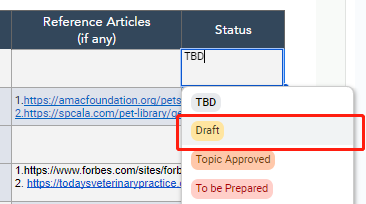
II. WMP Project Management:
- After approval of the topics, Campaign Specialist can proceed with the management of the big number of WMPs scheduled. This is an important stage in Campaign Management in general, to ensure that WMPs that could be time & resource consuming are scheduled ahead of time to be delegated to various stakeholders of the project.
- Firstly, taking a look at the list of “Topic Approved” list of posts, Campaign Specialist must decide which posts must be prepared fully in-house vs. to be outsourced to a Copywriter/Content Specialist, considering the schedule and department capability in this timeline.
- Campaign Specialist then sends a task to the Marketing Dept. Manager with the list of WMP Topic Posts that are to be handled in-house, the list to be outsourced to the Copywriter/Content Specialist List, and the estimated additional budget required for the services.
- Marketing Dept. Manager will review and reply over task whether the proposed time & budget allocation is approved. Once ready there are a few things to prepare before assigning the tasks in Sprint.
NOTE: Campaign Landing Pages are NOT to be assigned to a Copywriter, as it contains less content and every part of the content must be absolutely relevant to the campaign theme and objectives.
Creating Sub-folders
- Campaign Specialist can go ahead and create sub-folders for each WMP according to the timeline, following the template in the Server:
- Make sure that any files gathered in the Topic Selection (Research) phase are saved in the respective sub-folders for the WMP.
| Type of Post | Server Location | Sub-folder Name Template |
|---|---|---|
| Featured Contents, Blog Posts and Campaign Landing Pages | Z:\Shared drives\AdvaCare Marketing Control\AdvaCare Digital Marketing\AC_Marketing_Website Media Posts\[YYYY] |
[YYYY.MM.DD (of publishing) - [Featured Content/Landing Page/Blog Post] - [Theme Topic]
eg. 2024.04.12 - Featured Content - Veterinary Distribution Challenges 2024.04.19 - Blog Post - Avian Flu |
| SEO-Focused | Z:\Shared drives\AdvaCare Marketing Control\AdvaCare Digital Marketing\AC_Marketing_Website Media Posts\SEO-Focused Landing Pages\[YYYY] | [YYYY (of the project) - [Theme Topic] eg. 2024 - Top Companies or Manufacturer in [Country] |
Creating WMP G-doc File from Templates
- Locate the TEMPLATES for the Website Media Posts here:
- Copy the applicable template to each Sub-folder of the WMP, renaming the copied file as:
| Type of Post | Server Location | Template Name |
|---|---|---|
| Featured Contents | Z:\Shared drives\AdvaCare Marketing Control\AdvaCare Marketing Campaigns\TEMPLATES\MARKETING CHANNELS TEMPLATES\Website Media Posts | Featured Content TEMPLATE |
| Blog Posts | Blog Posts TEMPLATE | |
| Campaign Landing Pages | Campaign Landing Page TEMPLATE | |
| SEO-Focused | Z:\Shared drives\AdvaCare Marketing Control\AdvaCare Digital Marketing\AC_Marketing_Website Media Posts\SEO-Focused Landing Pages | SEO-Focused Landing Pages TEMPLATE |
NOTE: to better understand how each available SECTION on the website media posts look like, refer to the SOP - Media Article Post Creation - Section.
[Theme Topic] [Type of Post]
eg. Veterinary Distribution Challenges Featured Content
Avian Flu Blog PostCreating Sub-Tasks
- Locate the sub-task template under each Project’s Locate the sub-task template: Permanent Campaign: Website Media Posts > [Post Theme] TEMPLATE.
- Click on the top “Action” > “Duplicate” button.
- Once the duplicated sub-task is created, fill in the following fields:
- Sub-task title: according to the Post Theme
- Priority
- Deadline: Date of publishing
- Task description, as detailed as possible
- Save the sub-task created and repeat for every schedule WMP.
- Once all sub-tasks are created, Campaign Specialist can inform the Marketing Dept. Manager to include the tasks in the Marketing Dept. Sprint Planning, depending on the publishing schedule and copywriter schedule.
Coordinating Projects with the Copywriter
- Campaign Specialist will reach out to the Copywriter with the list of articles required together with the scheduled publishing dates and estimated deadline for the copywriter’s draft.
- Make sure the freelancers agree with the list of requirements and timeline.
- Once the project is confirmed by copywriter, Campaign Specialist will have to provide the following documents to the Copywriter:
- Keyword Research & Content Guideline Docs
- First outline of the WMP
- Once dates are confirmed, Campaign Specialist will update the task description of each WMP sub-tasks with updated dates, and send a task to the Marketing Dept. Manager on the expected dates of the copywriter’s milestone. Campaign Specialist is also required to set themselves an activity under each task on the agreed dates, to check with the copywriter on the status of each article.
These documents can either be prepared and provided in bulk, all at once, or in batches, depending on the Campaign Specialist’s available time. Refer to the next part of the SOP Step III. on how to create the article outlines.
Updating Campaign Roadmap Yearly, Monthly Schedule and WMP Status
- Locate the Campaign Roadmap Sheet and update the WMP publishing dates on the Yearly and Monthly Schedule to reflect the latest updates.
- On the WM Post Status Sheet, change the Status section of the WMPs:
- “Assigned to CW”: Assigned to the copywriter
- “To be Prepared”: Added in current or future Sprint to be prepared by Campaign Specialist
III. Outline Creation:
- Open the G-doc for each WMP article created in the previous stage.
- Develop the post theme into a fully fleshed-out topic that will captivate the reader’s interest. Ensure the topic aligns with the WMP objective (e.g., products, industry trends, etc.).
- Conduct additional keyword research to assign relevant keywords (KWs) for H1, H2, and content areas in the article.
- Fill in the sections highlighted in YELLOW for every G-doc. Leave the contents section blank for now.
- Once ready, send the outline to the Marketing Dept. Manager for review and approval.
- Once the outline is approved, it can move to the next step of content creation, which will be handled either in-house or by the copywriter, based on the complexity and timeline.
IV. Content Creation & Formatting:
Content creation and formatting will vary widely depending on the Type of Posts, which is mostly reflected on each TEMPLATE as is. However, refer back to the tables presented on the Type of Post & Tags section of this SOP for more information of the content and formatting per post type.
This section of the SOP is divided into three, content creation and formatting, even though when done in-house the first two steps are often done at the same time. Skip to the first section below, if the content section is outsourced to the copywriter.
1. Content Creation
The content specialist should follow the approved outline and integrate the focus keywords (H1, H2, and content keywords) throughout the article. Writing Tips include:
- Introduction: Start with a compelling intro that hooks the reader and outlines what the article will cover.
- Body: Ensure the body of the article provides value by being informative, engaging, and aligned with the outlined structure. Use short paragraphs, subheadings, bullet points, and visuals where applicable for readability.
- Tone: The tone should match the target audience (e.g., informative for B2B, engaging and relatable for B2C).
- SEO Optimization: Ensure the content is fully optimized for SEO, with proper keyword density, meta tags, alt text for images, and internal/external linking.
- CTAs (Calls to Action): Include any required CTAs based on the post type (e.g., distributor sign-ups, product inquiries for B2B, or social media shares for B2C).
2. Formatting
Format the article according to the WMP Blog Post or Featured Content template. In this stage, a few important sections are to be decided:
- Main Banners and Images: banners, images and infographics are to be prepared and its drafts to be filled into the article. Tasks to Design Specialist may need to be involved in the preparation of these images. After which, optimize the images by using descriptive file names and alt text containing relevant keywords.
- Links: internal links (within AdvaCare website) and external reference links must be included in the various sections of the article.
- CTAs and Other Elements: CTA or other dynamic links and contents from the WMP section templates are to be finalized in design, placement and destination links.
- References:are finalized.
- Spacing and Text Styling: Ensure proper spacing, headings, and text styling for clarity and readability. b. Use bullet points, numbered lists, and bold/italic formatting to highlight important information.
3. Final Draft Review
- Review the written content for accuracy, coherence, and adherence to the company's brand guidelines.
- Edit the content for clarity, flow, and readability.
- Verify that all sources are properly cited, and links are functioning correctly.
- Cross-reference the content against the outline to ensure all key points are covered.
- Proofread the content to eliminate grammatical errors, typos, and inconsistencies.
- At the end of this step, the G-doc must look as close as possible to the final results of how the article will look once uploaded, minus the description of each section.
- Task is to be sent to the Marketing Dept. Manager and BD Dept. Manager to review the final draft and provide feedback on the article. The task can be moved to the “Revision” stage.
- Once feedback from both Dept. Managers are received, revisions required should be addressed until the article is determined is final.
V. Final Review and Translation
After final draft approval, Campaign Specialist can proceed with the final revisions that include the finalizing the details of the article, such as:
-
UTM Links: Use of UTM links are normally not required other than for specific Campaign Landing Pages. In case UTM links are required, refer to the SOP: UTM Link Generation to create the UTM link(s) before incorporating them in the article.
- Image Compression, Names and Title Tag: standard image sizes for the articles are as follows. Image Sizes should be no more than 300kb. Any asset for the website needs to be compressed before uploading using Tinypng or a similar service.
- Translations: tools such as Google Translate are to be used for the articles.
- Open the article G-doc and click on the Tools tab.
- Select the “Translate document” option from the dropdown.
- Choose the intended language for translation, which will be Spanish and French, separately.
- Rename the new document to be the same as original, followed by either “- ES” or “- FR” for French and Spanish versions, respectively.
- The translated documents are automatically saved in the user’s G-drive, which Campaign Specialist has to manually move to the WMP folder for that article.
- Campaign Specialist must then highlight the CONTENT (not description of section) of the following sections, in light blue:
- H1, H2, H3s
- Custom URL
- Intro
- CTAs
- Quotation marks
- Meta Description
- And other sections deemed necessary for review, if applicable
- A task is to be sent to a fluent speaker of each language, to help review the quality of the translation. Refer to the Marketing Dept. Manager for the responsible persons of this task, if not clear.
- Hyperlinks: AdvaCare internal links have different URLs for pages in Spanish or French, and therefore the links must also be adjusted.
- Image Name and Title Tags: make sure that image files are also prepared for the Spanish and French versions, with translated image names and title tags.
- General Article Structure & Content
- Tile:
- Ensure the article title is correctly formatted and aligned with the approved outline.
- Confirm the title includes the focus keyword and is optimized for SEO.
- Introduction:
- Verify the introduction provides a compelling hook and clearly introduces the topic.
- Check keyword placement in the introduction, ensuring it appears within the first 100 words.
- Body Content:
- Ensure the article follows the structure outlined (H2, H3 tags for subheadings).
- Confirm logical flow and engaging content, free of grammatical errors or typos.
- Verify proper placement of focus and secondary keywords.
- Verify proper placement of focus and secondary keywords.
- Meta Description:
- Ensure the meta description is written and includes relevant keywords.
- Check that it summarizes the article concisely and aligns with SEO goals.
- SEO Optimization
- Focus Keyword:
- Ensure the focus keyword appears in the title, introduction, subheadings (H2, H3), and conclusion.
- Internal & External Linking:
- Confirm all internal links direct to the correct AdvaCare pages.
- Check that external links (if applicable) open in a new tab and point to credible sources.
- Alt Text for Images:
- Ensure alt text is written for all images and includes relevant keywords.
- Confirm that the alt text accurately describes each image.
- Media and Visual Elements
- Images and Banners:
- Ensure all required images are selected, formatted, and named correctly.
- Confirm that image sizes meet the required specifications:
- Main Banner: 1089 x 478 px
- Side Images: Width 369 px
- Full-Width Images: Width 712 px
- Verify that images are optimized and compressed to reduce file size (<300kb).
- CTA (Call to Action) Elements
- CTA Buttons::
- Confirm that the CTA buttons are clearly defined in the final draft.
- Ensure the buttons use action-oriented language and are linked to appropriate landing pages.
- Translation and Localization (If Applicable)
- Internal Links for Translated Versions:
- Confirm that internal links in translated versions direct to the respective language pages on the website.
- Review and Approval
- Final Review by Marketing and BD Dept.:
- Ensure the final draft is reviewed by the Marketing and Business Development Departments.
- Incorporate any requested revisions into the final version before uploading.
- Campaign Specialist is to send a task to IT Specialist to upload the article on DEV site, together with the link of the G-doc. Inform IT Specialist of the expected deadline.
- Communicate with IT Specialist to ensure that every section of the article is clear, particularly for more complex WMPs such as Featured Contents or Campaign Landing Page.
- IT Specialist will provide a link to the DEV page of the newly uploaded article for review. Campaign Specialist is to VERY CAREFULLY QA the uploaded article to ensure it appears as intended, including the image names and Meta Description.
- Campaign Specialist should take notes of any inconsistencies from the final draft, for the IT Specialist to review and revise.
- Sometimes, the uploaded version does not reflect certain parts as well as intended from the template, and therefore revisions may be required from the original final draft. Provide these suggestions to the Marketing Dept. Manager for approval and proceed accordingly.
- After the final uploaded article of the English version is fully QA’d and accepted by the Campaign Specialist, send a task to the Marketing Dept. and BD Dept. Manager for review and approval as well.
- With the confirmation of the English version, Campaign Specialist can proceed to request the Spanish and French versions to also be uploaded by the IT Specialist. Make sure that any revisions done on the English version since after, have also been implemented on the other two language versions.
- Repeat the same QA process for both other languages until confirmation.
- After all three articles are uploaded on DEV, Campaign Specialist is to check how the article reflects on the Media page of all 3 languages. Newly uploaded articles will always appear on the Media page, under the first Newsletter Subscription CTA section, highlighted as “NEW”.
- After confirmation that all 3 articles have been properly QA’d on DEV and appearing as intended on Media page, Campaign Specialist can send another task to the Marketing Dept. Manager to confirm the other 2 language versions as well.
- Campaign Specialist is to send a task to IT Specialist to feature said article, on which placement of the 3 featured articles.
- Once set as featured, Campaign Specialist must review the article title text placement over the banner image. Text must be clear and readable over the image. If not, adjustment to the banner image may be required.
- General Article Structure & Content
- Tile:
- Verify that the title is correctly formatted as H1 and reflects the focus keyword.
- Introduction and Body:
- Ensure the introduction, subheadings (H2, H3), and body content display properly, with no missing or misaligned text.
- Confirm that content matches the final approved draft and there are no formatting issues.
- Meta Description:
- Use Ctrl + U to view the source code and search for < meta name="description" content="...">.
- Ensure the meta description is inserted correctly and matches the approved version.
- SEO Optimization
- Keyword Placement:
- Confirm the correct placement of focus and secondary keywords in the title, subheadings, and throughout the content. Confirm the correct placement of focus and secondary keywords in the title, subheadings, and throughout the content.
- Internal and External Links:
- Check that internal links are functional and point to the correct pages.
- Ensure that external links open in a new tab and direct to credible sources.
- Media and Visual Elements
- Images and Banners:
- Verify all images and banners are properly displayed without distortion.
- Ensure images have the correct alt text with relevant keywords.
- Spacing and Layout:
- Ensure proper spacing between paragraphs and headings.
- Confirm bullet points, numbered lists, and text styling (bold/italic) are formatted correctly.
- CTA (Call to Action) Elements
- CTA Buttons::
- Verify that CTA buttons are functional and correctly styled (e.g., color, size).
- Ensure buttons are linked to the intended destination and there is no overlap with other content.
- Mobile and Cross-Browser Compatibility
- Mobile Responsiveness:
- Test the article on different mobile devices to ensure it is responsive.
- Check that all content (text, images, CTAs) is displayed correctly and is easy to read.
- Cross-Browser Testing:
- Review the article in different browsers (Chrome, Firefox, Safari, Edge) to ensure consistent appearance and functionality.
- Technical Considerations
- Page Load Time:
- Confirm the page loads within acceptable limits (<3 seconds).
- Ensure all images are optimized (compressed to less than 300kb) and not affecting load time.
- UTM Links (if applicable):
- Verify that any UTM links are correctly added and trackable.
- Final Review on DEV
- Comprehensive QA Review:
- Ensure all content is properly displayed and functional on the DEV site.
- Compile a list of any issues (e.g., formatting problems, broken links) and communicate them to the IT Specialist for corrections.
- After the articles have been published on PROD, Campaign Specialist will do a final round of QA.
- After the final QA, confirm over task to the Marketing and BD Dept. Managers that the WMP has been published successfully, and moves the stage of the WMP Task to “EXECUTION” stage.
- Set an Activity under the WMP Task for Launch date + 3 weeks to come back to the WMP for the WMP Performance Assessment and Reporting which is covered in this SOP: Assessment and Reporting.
- Distributor Featured Content: Newsletter & Social Media Posts (mandatory)
- Blog Posts: Social Media Posts (optional)
| Main Banner Size | 1089 x 478 px |
| Side Images | Width 369 px |
| Full Width Images | Width 712px |
Before publishing, do a QA for the final draft following this guide.
Final Draft Stage QA Checklist |
VI. Publishing and Review on DEV
With final review completed and translation either done or under review, Campaign Specialist can proceed to assign the task of publishing the original English version of the article on DEV. Before reviewing and proceeding with the translated
NOTE:Meta Description can be checked by using the shortcut Ctrl + U on the page, and the using the find function to search the phrase:
<meta name="description" content="
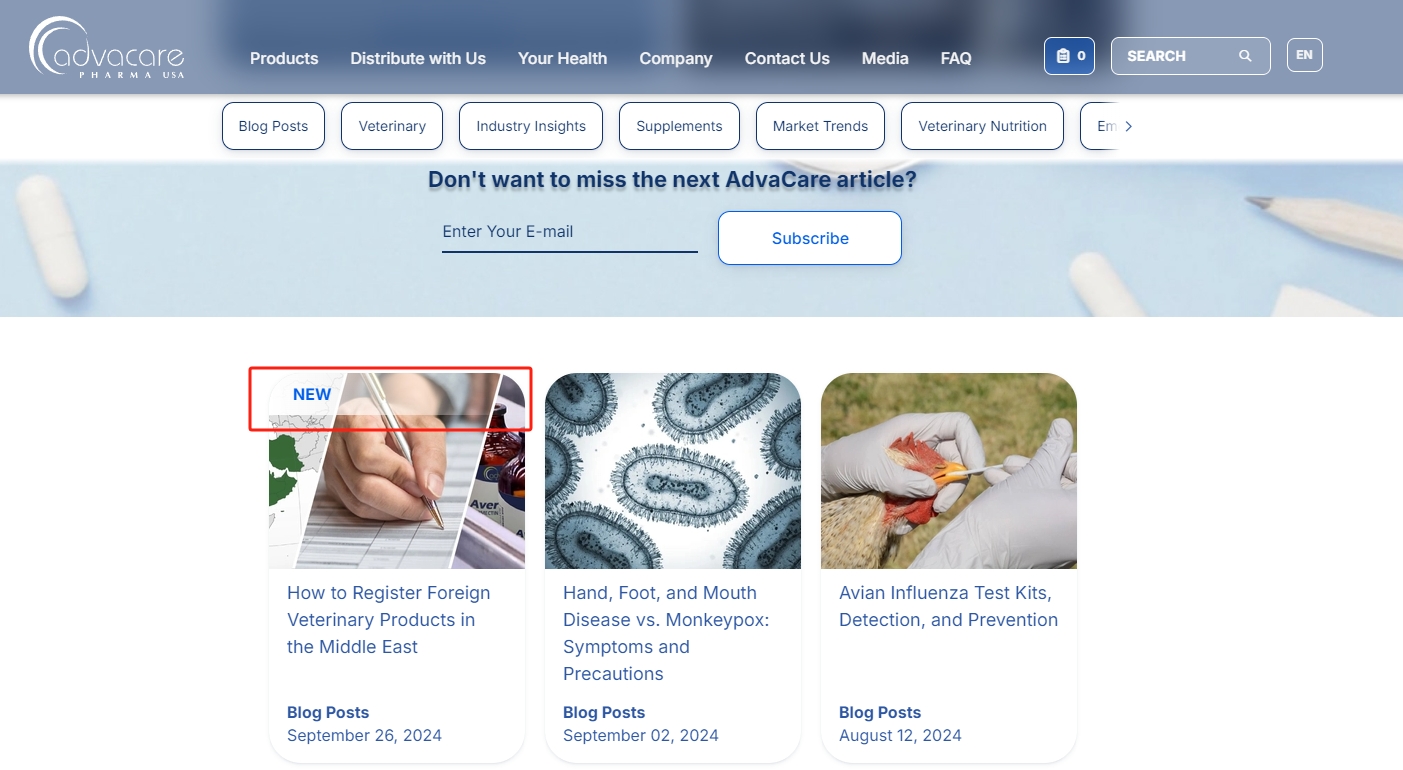
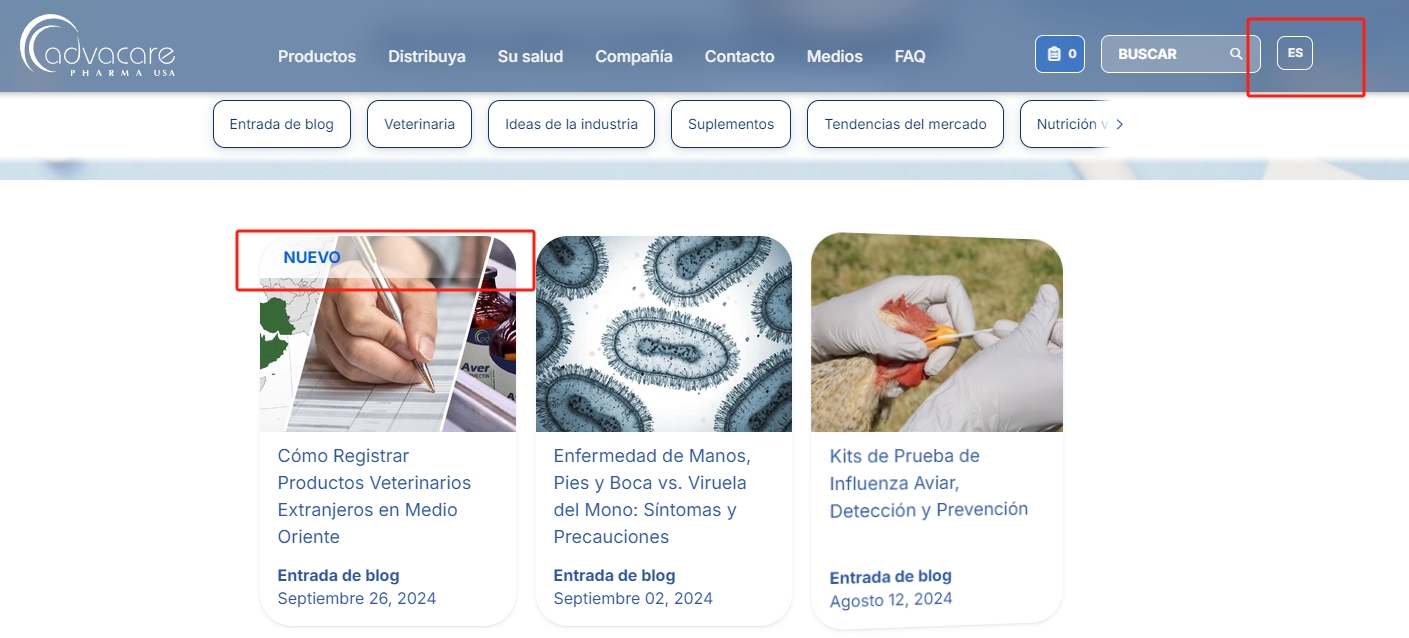
Setting an Article as “Featured”
Some articles may be decided to be featured as one of the top 3 posts on the Media page. This usually applies only to Distributor Featured Content type of post, but special cases may apply. When an article is decided to be featured, the following process is to be followed.
Post-Upload QA Checklist for DEV Site |
VII. Publishing and Review on PROD
The process of final publishing and review on PROD is not much different than the previous step, except that the publishing date MUST exactly match the scheduled date. This information is to be provided to IT Specialist with the task, for all 3 languages. Therefore some coordination related to both departments’ workload may be required.
NOTE: Pay attention to the internal links in the article, to make sure that no internal linking goes to DEV pages on the final product.
VIII. Promotion and Distribution:
The following types of posts are to be promoted and distributed via other marketing channels: